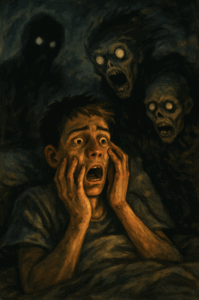Sleep Smarter – How Lifestyle and Relaxation Techniques Can Tame Nightmares
 While therapy and medication often take center stage in the treatment of nightmare disorder, sometimes the most powerful changes come from what we do outside the clinic — how we sleep, relax, and respond to stress.
While therapy and medication often take center stage in the treatment of nightmare disorder, sometimes the most powerful changes come from what we do outside the clinic — how we sleep, relax, and respond to stress.
In this article, we’ll explore simple, science-backed lifestyle changes and relaxation techniques that can reduce the frequency, intensity, and emotional distress of nightmares — especially when used alongside other treatments.
1. Sleep Hygiene – The Foundation of Better Sleep
Poor sleep habits can trigger or worsen nightmares. Good sleep hygiene sets the stage for more restorative, less disturbed sleep.
Key tips:
-
🕗 Stick to a consistent sleep schedule — even on weekends
-
🌙 Make your bedroom dark, cool, and quiet
-
📱 Avoid screens (TV, phone, laptop) at least 1 hour before bed
-
☕ Skip caffeine and heavy meals late in the day
-
💡 Use dim lights in the evening to signal your brain it’s time to wind down
2. Progressive Muscle Relaxation (PMR)
This classic technique helps calm both mind and body. It involves tensing and releasing different muscle groups, one by one, in a focused way.
🔁 Practice before bedtime for 10–15 minutes
🎧 You can follow guided PMR tracks on YouTube or relaxation apps
In a randomized trial, PMR reduced nightmare frequency by up to 80% when practiced consistently.
3. Guided Imagery & Visualization
Before sleep, visualize a calming, peaceful scene — like a beach, forest, or safe room. This primes your brain for non-threatening dreams.
🖼️ Some people combine this with Image Rehearsal Therapy (IRT) by rehearsing a changed version of a past nightmare
🧠 Works by reducing fear circuits and promoting relaxation during REM sleep
4. Mindfulness & Breathwork
Mindfulness doesn’t stop nightmares — but it reduces the fear response to them.
Try this before bed:
-
Breathe in for 4 counts
-
Hold for 4 counts
-
Breathe out slowly for 6–8 counts
-
Repeat 5–10 cycles
🧘 This technique activates the parasympathetic nervous system and calms hyperarousal — a key trigger in PTSD-related nightmares.
5. Hypnosis
Hypnosis helps patients reframe their response to nightmares and increase self-control in dream content.
In case series, over 70% of patients had sustained improvement in nightmare frequency with just 1–2 sessions.
🎯 Works best when guided by trained professionals
🌀 Useful for people with trauma-related or idiopathic nightmares
6. Lucid Dreaming Practice
Some patients benefit from learning to become aware during their dreams — and take control of the narrative.
👁️ Start by keeping a dream journal
🧭 Try “reality checks” during the day (“Am I dreaming?”) to build awareness
🛌 Over time, you may begin to recognize dream patterns and intervene while dreaming
7. Limit Alcohol, Cannabis, and Medications That Disrupt REM Sleep
These substances may suppress REM initially and then cause REM rebound, making nightmares more vivid and intense.
⚠️ If you’re on medications that impact sleep architecture (e.g., some antidepressants), speak to your doctor before making changes.
Coming Up Next
In the next article, we’ll discuss how to personalize treatment for nightmare disorder — balancing evidence, clinical judgment, and patient preferences.
About the Author
Dr. Srinivas Rajkumar T
Consultant Psychiatrist
Apollo Clinics – Velachery & Tambaram, Chennai
📞 Phone: 8595155808
🌐 www.srinivasaiims.com
💤 Empowering patients to rewrite their nights — with science, care, and compassion
You don’t need pills or years of therapy to begin healing from nightmares. Sometimes, all it takes is a few gentle changes — and a willingness to rest differently.